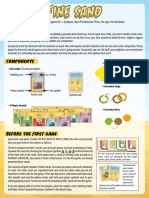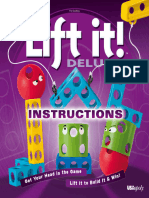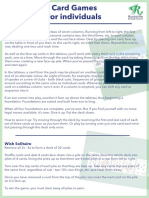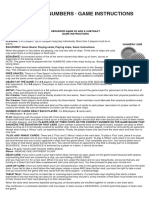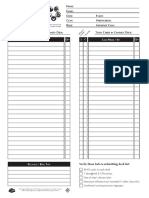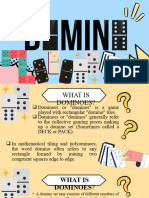Videorules:
www.thebrainyband.com
Players: 2–5
Age: 5+, 8+ years
d game (depending on the rules variant)
c i t i n g boar Time : 10–20 minutes
Ex
R ULES
GAME
“Multimany” is the only game of its kind where children get to become acquainted with the arith-
metic function of multiplication. Using specially developed methodology, children are taught about
multiplication visually and naturally, relying on visual, thematic cogitation rather than mechanical
memorization of wordy “formulas”.
The idea of the game is that the players need to “construct buildings” consisting of two cards so that
when they are placed on top of each other, the player arrives at a particular number of windows.
Rules of the Game “Multimany”
The Game “I See!” (5 years and up, 2–5 players)
Six building cards are taken out of the
pile and laid out on the table. The build-
ing pile and the numbers deck are placed
next to each other.
The players take turns rotating in a clock-
wise fashion. Whoever the players agree
should go first goes first.
Six Building Cards
During his turn, a player draws the top number card from the deck
and lays it face down. Meanwhile, the player must place the card in
The Correct Way such a way that he can’t see it any sooner than the other players (away
to Lay Out a Card from the corner closest to him) at the moment he turns it face up.
The players immediately try to find two building cards amongst the six building cards displayed
faster than everyone else that multiply to equal the same number of windows as displayed on
the number card that was drawn. They can also reach the number of windows indicated by put-
ting two or three buildings together (the number of windows in them is added up).
Meanwhile, they are not allowed to touch the cards.
= = +
Cards Layout
If one of the players manages to find the combination that multiplies to equal the indicated
number, he yells “I see!” and covers the number card with the palm of his hand. After that, he has
to show how to assemble the building (buildings) that equals the number. Each building abso-
lutely must consist of two cards, which are placed on top each other so that their stripes intersect
(are perpendicular to each other).
After combining the correct cards, the player collects the number card (to be counted up at the
end of the game) and the building cards he used are discarded. If nobody is able to win the num-
ber card, then it is discarded as well.
If a player yells “I see!”, but in the course of three seconds he doesn’t show how to construct the
building with the necessary number of windows, then he loses the turn as a form of a fine (he
won’t be able to take a card during that turn).
The game ends when all of the number cards run out. If the buildings deck runs out then it will
need to be shuffled along with the building cards from the discarded pile to be brought back
into the game.
Simplified rules for learning the game or playing with small children:
› Only use building cards with 1, 2, or 3 transparent stripes on them and
number cards no higher than 9.
› Don’t play to see who can go the fastest, but rather take turns instead.
The only player who will be able to yell “I see!” will be the player whose
turn it is (who drew the card).
�Major Construction Game (8 years and up, 2–3 players)
The building cards are shuffled and placed onto the table in a 5 × 5 square format (the remain-
ing five cards aren’t used) and an chip is placed onto the card in the center. This is a “construction
panels warehouse” out of which the players will have to erect buildings. Just like in the “I see!”
version, each building erected will absolutely have to consist of two cards placed on each other
and the amount of windows must match the number on the number card.
The players are passed out 3 number cards, each turned face up. Players take turns in a clock-
wise fashion. In the beginning, players agree who will go first (if there are multiple games going
on, then the person who accumulated the least points in the previous gave can go first).
Constructing a Building
A player does the following during his turn:
1. He moves the chip onto an adjacent card — up, down, left, or right (he can’t move it diag-
onally). If some of the building cards are already gone, then the nearest card in that particular
direction will be considered adjacent.
2. He places a card out of the “warehouse” onto the card where the chip landed, onto the “con-
struction site”, and he is able to construct buildings using cards he places on top of the card with
the chip on it.
Construction site
Major Construction
3. He tries to arrive at the number indicated on one of his number cards, if he has the option, by
assembling the corresponding building. In order to do so, he may use any of the cards located
on the “construction site”. He places the building he constructed and the matching number card
into his personal pile to be counted up at the end of the game (these cards no longer participate
in the game process).
4. A number card may not be matched by constructing only one building, rather only by con-
structing two or three buildings simultaneously (the number of windows is multiplied). In the
course of a turn, a player may only match one number card.
At the end of his turn, the player adds number cards from the deck, if necessary, to ensure that
he always has three and then it becomes the next player’s turn.
If during the course of the game, the chip ends up in a position where it can’t be moved to any
other card, then the player can move the chip two times during his turn, either vertically or
horizontally (the first move leading to an empty space and then the second one leading to
a card).
When There Are No Moves Left
The game ends when there are no more buildings left on the playing field that are able to equal
the numbers on all the players’ number cards. At that moment, the players count up all the
points they’ve accumulated, placing all the number cards onto the number cards that have
already been matched.
Variation of the Major Construction Game:
› To make the game more of a challenge, you can put out all 30 cards in the form of a 5 × 6 rect-
angle (the chip is placed on any of the two cards in the center at the discretion of the player
passing out the cards).
› To make the game easier, you could use only building cards consisting of between 1 and 3
transparent stripes and number cards going no higher than 9. In this case they will be dis-
played in the form of a 4 × 4 square or a 4 × 5 rectangle.
Other educational games on the website www.thebrainyband.com
V. 1.2016










